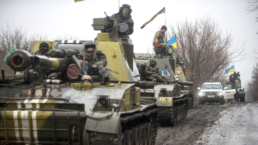Absent a compromise settlement, massive levels of aid for Kyiv would have to continue, perhaps indefinitely.
by George Beebe and Anatol Lieven, Responsible Statecraft
Russian progress in the Ukraine war is pushing the United States toward a painful choice.
If we want a prosperous Ukraine with a viable path toward liberal governance and European Union membership, we will have to concede that it cannot be a NATO or U.S. ally, and that this neutral Ukraine must have verifiable limits on the types and quantities of weapons it may hold. If we refuse to agree to those terms, Russia will quite probably turn Ukraine into a dysfunctional wreck incapable of rebuilding itself, allying with the West, or constituting a military threat to Russia.

Russian progress is not yet evident on the map, where the battle lines have not moved appreciably over the past year. Ukraine’s counteroffensive failed to break through Russian defenses, and Russia has not pushed Ukrainian forces significantly westward. An observer comparing territorial holdings in January 2023 with January 2024 might reasonably conclude that the war has become a stalemate.
But this picture is misleading. The Kremlin is almost certainly not seeking such a breakthrough, at least not yet. Rather, it is methodically grinding down Ukraine’s capacity not only to wage war, but also to reconstitute a post-war military, by killing and wounding enormous numbers of Ukrainian soldiers and exhausting Ukrainian and Western arsenals of arms and ammunition. Ukraine is running short of artillery shells, and the U.S. and Europe cannot manufacture new ones quickly enough to meet Ukraine’s needs. Russian barrages of long-range air and missile strikes are increasingly overwhelming the capacity of Ukrainian air defenses, and the West simply lacks the ability to continue providing Patriot missiles or other advanced air defense systems.
Recent Posts
Politicians Are Betraying Gen Z On Climate
July 10, 2025
Take Action Now While Gen-Zers thrift, knit, crochet, and find other ways to reduce our footprints, Trump and the GOP are greenlighting more climate…
Trump’s Deportation Threat Against Zohran Mamdani Is Shameful
July 10, 2025
Take Action Now In only half a year of Donald Trump’s presidency, he and his allies have turned deportation into an explicitly political threat…
Teachers Union Votes To Cut Ties To The Anti-Defamation League
July 10, 2025
Take Action Now In a momentous vote, the National Education Association voted to cut all ties with the Anti-Defamation League. The reason? “Despite…
2025 War Abolisher Awards Go To Albanese, Nader, Waters
July 9, 2025
Take Action Now The purpose of the awards is to honor and encourage support for those working to abolish the institution of war itself.By World…




